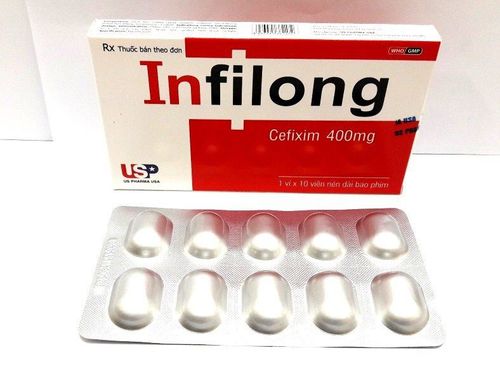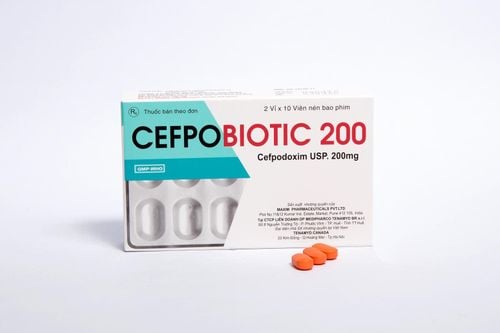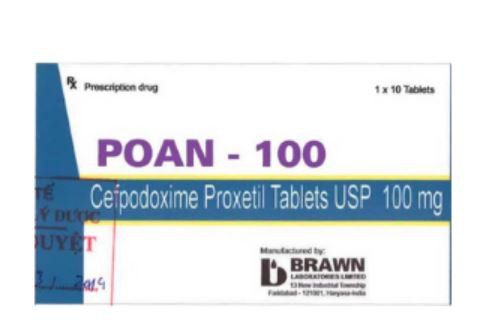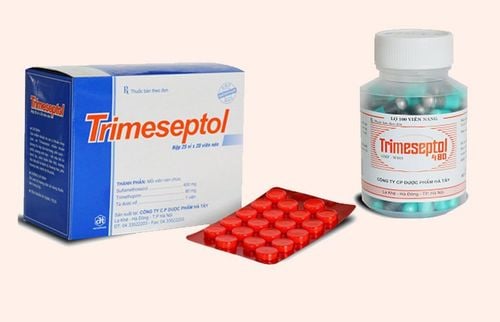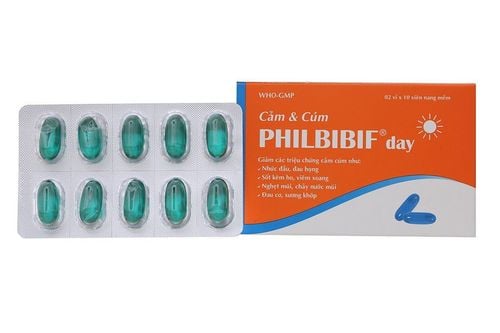This is an automatically translated article.
Nifin 200 is used in the treatment of pneumonia, tonsillitis, sinusitis, urinary and skin and soft tissue infections. Medicines that require a prescription from a doctor or pharmacist. Be warned when using for people with kidney failure, pregnant and lactating women.
1. What is Nifin 200?
Nifin 200 belongs to the group of drugs to treat parasites, anti-infectives, antivirals, antifungals. The drug is prepared in the form of film-coated tablets packed in boxes of 2 blisters x 10 tablets. In each Nifin 200 tablet contains the following ingredients:
The main ingredient is Cefpodoxime in the form of Cefpodoxime proxetil 200 mg. Other excipients such as: Sodium starch glycolate, modified starch, Aerosil, Sodium lauryl sulfate, Croscarmellose sodium, Magnesium stearate, Ludipress, Talc, Titanium dioxide, HPMC 606, HPMC 615, PEG 6000, Red iron oxide.
2. Indications for using Nifin 200
Nifin 200 is indicated for the treatment of the following infections:
Upper respiratory tract infections including acute otitis media, tonsillitis, sinusitis and pharyngitis. Acute pneumonia. Acute gonococcal infection. Urinary tract infection. Skin and skin structure infections. Treatment of lower respiratory tract infections.
3. Dosage and how to use Nifin 200
Nifin 200 is used for oral administration and taken after meals.
Dosage depends on each patient and medical condition.
Adults and children > 13 years old:
Treatment of tonsillitis, pharyngitis, mild to moderate urinary tract infections: dose of 100 mg Cefpodoxime (1/2 tablet) x2 times/day. Drink once every 12 hours for 5 - 10 days. Treatment of chronic bronchitis, otitis media, mild and moderate acute pneumonia: 200mg Cefpodoxime (1 tablet) x 2 times/day. Drink once every 12 hours for 10-14 days. Treatment of skin infections: 400mg Cefpodoxime (2 tablets) x 2 times/day. Drink once every 12 hours for 7-14 days. Treatment of gonorrhea: A single dose of 200mg Cefpodoxime (1 tablet). Renal impairment:
Clearance < 30 ml/min, without hemodialysis: Usual dose 24 hours apart. Patients on hemodialysis: Use the usual dose of Cefpodoxime 3 times a week. Or use Cefpodoxime as directed by your doctor or pharmacist. In case of liver failure:
No dose adjustment of Cefpodoxime is required in patients with cirrhosis.
4. What to do when overdose, forget dose of Nifin 200?
There have been no reports of overdose with Cefpodoxime. In the event of an overdose, Cefpodoxime should be urgently treated symptomatically for other cephalosporins or taken to eliminate the drug from the body. In the event of a life-threatening emergency, the patient should immediately go to the nearest medical facility for timely treatment.
If the patient forgets a dose of Cefpodoxime, take it as soon as possible when you remember. However, if it is almost time for your next dose, skip the make up dose and take your next dose at the scheduled time. Do not double the dose of Cefpodoxime.
5. Contraindications to using Nifin 200
Nifin 200 should not be used in the following cases:
Patients with a history of hypersensitivity to Cefpodoxime or to any of the excipients in the drug. People who are allergic to Cephalosporins, Porphyrin metabolism disorders. Patients with a history of severe allergy or anaphylaxis to penicillins or other beta-lactams. Children < 2 weeks old.
6. Nifin 200 . drug interactions
Here are some drugs when combined with Nifin 200 that can cause drug interactions such as:
Cefpodoxime with antacids or H2 inhibitors will reduce plasma concentrations by about 30%. When Cefpodoxime is administered concomitantly with compounds known to be nephrotoxic. Therefore, renal function should be closely monitored. Cefpodoxime combined with probenecid will increase the concentration of cefpodoxime in the blood plasma. Cephalosporins make Coomb's test direct (-).
7. What side effects does Nifin 200 cause?
When using Nifin 200, patients may experience side effects that are usually mild and transient.
Diarrhea Nausea, vomiting. Colitis Itching, skin rash. Dizziness and headache. Thrombocytopenia, thrombocytopenia, leukopenia, eosinophilia. Liver enzyme disorders, cholestatic jaundice, hepatitis. Reversible interstitial nephritis. Excitement, hypertonia, trouble sleeping. Immediately inform your doctor or health care professional of any unwanted side effects when using Cephalosporins or go to the nearest medical facility for timely treatment.
8. Precautions when using Nifin 200
Do not use Cefpodoxime with patients who are sensitive to Penicillin Cefpodoxime should be used with caution in patients with renal insufficiency. Cefpodoxime should not be used in the treatment of atypical pneumonia caused by organisms (Legionella, Mycoplasma, Chlamydia ), in the treatment of pneumonia caused by S. pneumoniae. Cefpodoxime should be used with caution in people with a history of gastrointestinal disease (colitis). Because overgrowth of non-susceptible organisms is possible. If patients using Nifin 200 have dizziness, headache, they should not drive or operate machinery. There are no reports of the use of Cefpodoxime in pregnant women, so use only when clearly needed. Cefpodoxime has been found to be excreted in breast milk, but at low concentrations, it can affect the gut microbiota in the neonate.
Please dial HOTLINE for more information or register for an appointment HERE. Download MyVinmec app to make appointments faster and to manage your bookings easily.





